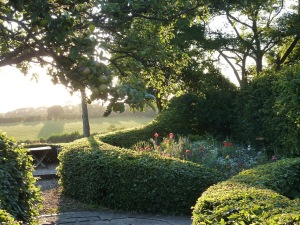An interview with Graham Cousins
During a family vacation to Provence in the Summer of 2011, Graham Cousins and I sat down in the shade to talk about gardens and life.
Q: Where was your first garden?
A: My mother gave us little bits of garden at home in Rugby and we grew things like radishes. But apart from those, my first garden was in Brighton Avenue in Leicester. Some of my earliest memories are of natural landscapes. We lived on the edge of Rugby in an area that had been newly built in the 1930s. When the Second World War began, the government stopped all building. So there were partially built houses near us, and these became an adventure playground for us boys. Between the concrete and the bricks and things that had been left, nature began to take over. To this day I can remember my mother loving to grow pansies, violas, and other flowers. I was fascinated to discover wild ones growing between bricks on those abandoned building sites.
I remember my mother taking us on walks through the Wye Valley, a particularly beautiful part of Britain, and saying, “Do you know there are flowers that have squares on them like a checkerboard on a chessboard?” And I thought, “She’s making this up. This can’t be true.” It is true, in fact. My mother got me interested in flowers and natural landscapes.
Q: When did you realize it was more than a hobby?
A: I think it was in the late 1970s, when I was in my 40s. Yes. Very often people get gardening at that sort of age. They say people either get God or gardening in their later years.
Q: Is there an early built influence you can recall?
A: Hidcote Manor Garden in Gloucestershire. It’s a National Trust property now. It was made by an American, actually; an American who was born in France and who became a naturalized British citizen. Hidcote Manor opened my eyes up to possibilities. I remember being particularly fascinated by two things. One was the fact that the garden was divided into rooms; rooms where the walls were hedges. This was important in two ways. First of all, because it gave shelter from the turbulent English climate, so there was a sense of peacefulness in these little compartments. And also because it enabled different, distinct color and flower schemes in each of these compartments. But the whole thing was welded together by long vistas between the compartments, out onto the wider landscape. This was the first time I had the sense of greatness in gardens.
Another thing which, very early on, affected the way I garden was Beth Chatto’s The Dry Garden. She made me aware of the connection between natural plants, communities, and gardens.
I think the first good garden we had was in what was called Woodville Gardens. We had a new house with an empty garden, not a large garden and in the suburbs. But I remember making a square pond with a natural stone edge and putting up two hedges and having, perhaps, a slight glimpse of Hidcote in this suburban garden. I remember thinking, “This is quite good, but I need more. I must be in the countryside, and I must have more space.” And that’s why we moved to Walton eventually, in December 1981.
Q: It has been completely reinvented. It wasn’t really much of a garden when you got there, was it?
A: Not at all. I would say it was like a rural shantytown; there were eight corrugated iron buildings dotted around. It had been a sort of smallholding, but the man who owned it was also a self-employed builder. It took us about two years to clear away all these sheds. And at one stage I think we became the major dealers in secondhand corrugated iron sheeting in South Leicestershire; we had incredible quantities of tin sheets. There was a little orchard on one side with all apple and pear trees. And there were a couple of other good old trees, but that was about it.
Q: What was your first concept for the garden?
A: I was very much enthralled to Lutyens and Jekyll and the Arts and Crafts tradition of gardening. I drew out a rough plan on a piece of graph paper, which showed a straight line between what was then our living room window and a church about two miles distant across the fields, and made that the main vista. This led to difficulties later on, because the vista was not quite parallel to the line of the house as it began to edge out towards the fields.
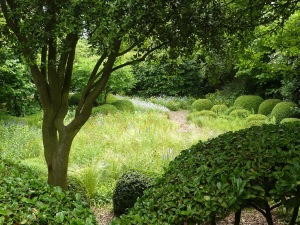 |
| Micro meadow in early summer |
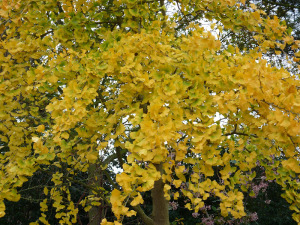 |
| Gingko leaves in autumn |
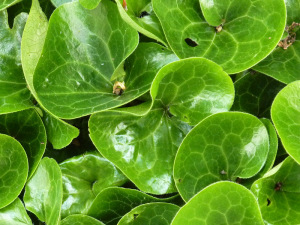 |
| Asarum Europaeum thrives in woodland |
Q: Did you feel like there was a first phase to the garden?
A: It was a geometric layout with a vista and garden rooms. I wanted garden rooms like those at Hidcote. I was in a huge hurry and tremendously ignorant. I planted lots of Leyland cypresses in lines to make rooms. But, of course, Leyland cypresses are hugely vigorous trees. I planted well over 100 of these things, and they would have been quite impossible to control long term. So the first phase looked good, but I couldn’t control them. I had to dig them all out again and replace them with hornbeams, a native English tree which makes a good hedge. The pond was originally a rectangle. It’s now a circle, but I’d like to change it again.
Q: When it was rectangular, was there a hedge around the pond?
A: Yes, and also raised beds. The soil from the excavation, which I dug by hand, was used to make the beds. But since the soil was light, sandy loam, to have raised beds was an absurd thing, because everything drained away so quickly already. I made so many mistakes. In a way, that made it all harder for me, but in another way, it meant I learned a lot of practical lessons over the years, because I had only myself to answer to. Once I realized I had made a mistake, I was willing to put it right.
Q: And so then what came next?
A: I wanted less geometry. And I became much more interested in the shape of trees and shrubs, which has become one of my overriding interests. I wanted there to be more interesting subtle vistas. Glimpses, that’s it. I wanted there to be glimpses. As you progressed around the garden, you could look up in different directions and see interesting shapes and light effects.
Q: When did you get rid of the idea of flowerbeds?
A: As I mentioned, in the early days I was very much enthralled with the Lutyens-Jekyll pattern, which was maximum formality of layout and minimum formality of planting. I thought what you needed was hedges and then informal layouts of plants with lots of flower color. In those days, I used to have variegated plants, purple-leafed plants, and gold-leafed plants, none of which I have now. I realized that I was spending more and more time in the one area of the garden where all the leaves were green. And I also noticed that when people came into this section, they would breathe in deeply and say, “Ah, this is wonderful.” And I don’t think they really knew why it seemed so wonderful to them, but there’s a magic to green leaves, which all these colored-leafed plants take away. They break the enchantment. If you put in colored-leafed plants, the garden may be very smart, like a florist’s shop, perhaps, very eye-catching, but it won’t have the magic. Green leaves are, for our part of the world anyway, the natural leaf color. Also, it gives a unity to the garden if the base color is green.
And I remember I was right down to a couple of trees in the field hedge, poplars with variegated leaves, and a garden writer said, “Graham would never plant colored-leafed plants next to the countryside.” The day after reading that article, I got the tree surgeon in to cut them down quickly. So that was the end of it. Now it’s all green.
Q: But there are still some moments of color with wildflowers?
A: There are flowers in the garden. Flowers are important, actually, as markers of time. If a garden doesn’t mark the seasons, then it will lack a fundamental dimension. So many gardeners deny the passage of the seasons. It’s a sort of greed. They want to have flowers all the year around and flowers that last for months on end. They celebrate certain kinds of hybrid roses. This is received wisdom in the horticultural community. But I think flowers should mark the seasons and be ephemeral and fleeting.
I suppose this idea came from my visit to Japan, when we saw the cherry blossoms in bloom. The more I studied the Japanese garden, the more I recognized how Japanese gardening is based on the seasons. After the spring flowers, we have the greenery of summer and then the reds, yellows, and golds of autumn. And then the bare branches in winters, snow on the branches, and then the buds again, and so the year’s cycle is completed.
Q: It seems like what you’ve been advocating is a garden that also feels very much a part of its place. In other words, your garden isn’t something you’d see here in Provence.
A: No. It’s a garden that belongs to the British Midlands.
Q: How do you see gardening in relationship to other artistic endeavors? You share it by opening it during those mostly summer months. Do you perceive it as an artistic endeavor?
A: Gardening is an art and a lot of gardening is bad art. What’s unique about gardening as an art form is that it’s some sort of cooperation between man and nature, where man is never entirely in charge. And this is part of its fascination, I suppose.
I feel that gardens should be based on natural cycles and on ecological principles. In other words, you shouldn’t try to grow plants that would be suited to the top of a mountain if you live in Midland England. You should understand principles of ecology. A woodland has a canopy, a shrub layer, and a ground cover, a floor. And each one has typical species which occupy those sections of the ecosystem.
The ecosystem and the natural rhythms are fascinating, because you have everything from trees that might last 1,000 years to flowers that might last only a few weeks. There are complicated series of cycles going on in gardens, and this is part of the art of gardening: to incorporate these things into your artistic effort.
Q: Is this related to why it doesn’t really concern you that gardens are, in some way, fundamentally temporary?
A: I don’t worry about that. Gardening is a process, and you can try to record it with photographs or paintings, but there are some things that are almost impossible to record. I’ve learned recently, for example, that the shine on lustrous leaves is impossible to photograph, or so a professional photographer told me.
As we sit here under this tree, the wind is moving the branches. And then there is scent. There are so many different elements to gardens that are transitory and impossible to capture. With gardening, you’re always looking forward. It’s always going to be better next year. It will never be perfect, of course, but it’s always going to be better.
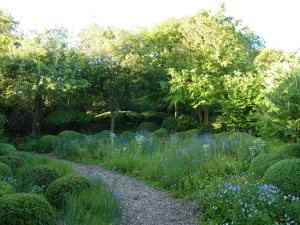 |
| Perennial meadow flowers in July |
